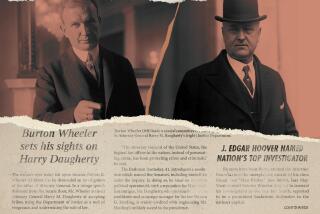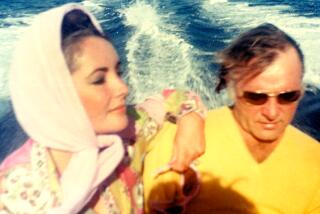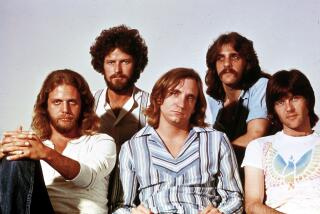COLUMN ONE : Still, There Is a Lost Suitcase : Almost everything Hemingway wrote or touched, it seemed, had been saved. Then some old newspaper stories were found. One thing is clear: He never shirked an assignment.
TORONTO â Discoveries of the lost works of literary masters are always exciting, but never more so than when it is an uncertified digger who makes the great find.
Last year, with the Toronto Starâs 100th anniversary in sight, an assignment editor at the paper, Canadaâs largest-circulation daily, asked for volunteers to write historical features as part of a yearlong commemorative project. William Burrill lunged greedily at the chance to tell of the Star in the 1920s.
Toronto, the twenties, the Star. . . . Wasnât Ernest Hemingway writing for the paper back then?
Indeed he was, though Burrill needed no one to jog his memory. A prematurely graying entertainment writer who favors paisley shirts and John Lennon glasses, Burrill is a local keeper of the Hemingway flame--so faithful a keeper that he has patterned much of his own life along the lines of the Nobel laureateâs extravagant resume.
In the Hemingway mode, Burrill has bummed his way around a number of sunny and artistically provocative settings: California, Mexico and Southern Europe. He has hung out in cafes, broken off a romance in favor of the hard and stony road of experience, written a novel and assembled a collection of rejection letters, a la Hemingway. He reads everything he can on the âmoveable-feasterâ and the âlost generation.â
And, as Hemingway often did himself, Burrill slinks back to day-to-day journalism when the money runs out. Since fall, he has been the managing editor of a free entertainment weekly published by the Star and the writer of a syndicated column on childrenâs video games.
From Burrillâs perch, the Starâs Hemingway project looked like a made-in-heaven excuse to finance a right proper crawl of the great oneâs Parisian haunts.
âReally, all I expected to do was a feature story,â says Burrill. âIt was supposed to be, âDid you know Hemingway wrote for the Star? Surprise! He did.â â
But instead, after lengthy slogs through several Hemingway archives, Burrill stumbled upon a trove of lost newspaper stories by the expatriate American newsman who would later go on to write âA Farewell to Arms,â âFor Whom the Bell Tollsâ and âThe Old Man and the Sea.â
The Star published some of Burrillâs booty in a special weekend section Sunday. Although American Hemingway scholars havenât had a chance to evaluate the materialâs authenticity, one Canadian expert has already said itâs the real thing.
The newfound articles, three of which predate what was previously thought to be Hemingwayâs first Star byline, treat such stock-in-trade Hemingway themes as boxing, camping and bullfighting, the latter subject not theretofore closely reported on by the Canadian press.
A reader who goes through them in chronological order can watch as the author matures from an unexceptional writer of news to an artist with a gift for spotting details and getting them down on paper with the right words in the right places.
There are humor pieces, an unpublished diatribe against the mayor, and a beautifully composed portrait of French Premier Georges Clemenceau--one that the Star refused to print. (Star editors were offended because Clemenceau had the wholly incorrect idea that Canada had refused to fight in World War I.)
In other articles, Hemingway plainly struggles to make the best of workaday city desk assignments. One Christmas season, he got stuck writing a tear-jerker for the Starâs annual Santa Claus Fund drive.
âShe had worked until she had become a shadow,â the 23-year-old Hemingway wrote in an uncharacteristically florid profile of an impoverished single mother. âHer big eyes in sunken lids seemed to hold flame as they glowed from the pallid transparency of her thin face. . . .â
Hemingway, in a closing paragraph, invites guilt-riven readers to send contributions to the paper.
âWhat impresses me about him is, he never kissed off an assignment,â says Burrill, adding that he is especially drawn to a simple but well-written 1923 story about the toll automobile fumes were inflicting on Torontoâs oak trees.
Burrillâs discovery has intrigued the worldâs numberless Hemingway students, though not because anyone expects the articles to cast much new light on Hemingwayâs development as a writer. Hemingway has been too exhaustively biographied for that.
Rather, publication of the material underscores the success of a mere newspaper writer, untrained in the arts of literary scholarship, in mining a vein everyone thought was played out long ago and coming up with gold.
âItâs amazing that these (articles) are just surfacing now,â says Ronald Weber, a professor of American studies at the University of Notre Dame and the author of âHemingwayâs Art of Nonfiction.â âThereâs just all sorts of people crawling all over the Hemingway files at the JFK Library.â
(The John F. Kennedy Library in Boston, part of the National Archives, is the home of Hemingwayâs manuscripts, letters, to-do lists, doodles, expense accounts--the bulk of his exceedingly bulky papers.)
Burrillâs discovery is certain to fire the imaginations of Hemingway devotees around the world, troubadour scholars who perhaps dream of stumbling onto the novelistâs famous suitcase--the one stuffed with all his earliest fiction and stolen after his first wife, Hadley, briefly left it unattended in an overhead baggage rack aboard a French train.
None of those manuscripts has ever been found.
Until now, the world had assumed that all of Hemingwayâs Toronto Star stories had been identified and printed in the 1985 collection âErnest Hemingway: Dateline Toronto,â published by Charles Scribnerâs Sons. It is a comprehensive book, chockablock with everything from a gag piece about being shaved by student barbers to unsigned, one-paragraph briefs filed from Europe.
âI wouldnât be surprisedâ if the discovery led to a revised edition of âDateline Toronto,â says William White, editor of the collection. âWeâre all (still) interested in Hemingway.â
The tale of Burrillâs detective work turns out to have its own share of literary elements: human loss, the diligence of a lonely eccentric over decades and the exertions of a young reporter who refused to take it for granted that all of Hemingwayâs newspaper work had been accounted for.
Burrill had a leg up on the average Hemingwayfarer when he embarked on his research. Right there in the Toronto Star building, a high-rise on the north shore of Lake Ontario, he had access to a vast, but little-visited, cache of Hemingway materials.
It was put together by yet another Toronto Star staffer, the late, virtually unsung William McGeary.
McGeary, who died in 1984, was, in Hemingwayâs time, one of the Starâs highest-flying reporters. But his career as a newsman came to an abrupt halt in 1935, when he backed out of his driveway one morning and struck and killed his 3-year-old daughter.
McGeary was shattered. The Star took him off its reporting staff and assigned him to the library, where he seems to have discovered that by researching Hemingway, he could forget about his grief for at least eight hours a day.
For more than 20 years, McGeary tracked down every article Hemingway had ever written for the Star, including the anonymous ones. He annotated his collection extensively--almost obsessively. He even came up with five pieces that he felt certain were Hemingwayâs but couldnât get any expert to confirm.
The Princeton University scholar Carlos Baker made extensive use of McGearyâs files in writing his definitive 1969 biography of Hemingway. But by the time Burrill came on the scene, the papers had been locked up, crumbling and gathering dust, in an office off the Starâs library.
It was Burrillâs original plan to browse through the files to see what Hemingway had been writing about back in the 1920s and what Toronto was like then. (It was by all reliable accounts stuffy and Victorian to beat the band--a far cry from the Toronto of the 1990s. Today, one of Hemingwayâs former residences is home to a thriving gay bar.)
Near the bottom of McGearyâs vast files, Burrill found the five articles McGeary had tried in vain to attribute to Hemingway.
Intrigued at the thought of âhiddenâ Hemingway, Burrill read the record more closely. That was when he noticed an odd, four-month gap--May 16 to Sept. 15, 1923--in which Hemingway was affiliated with the Star, yet seemed to have produced nothing.
As it happens, those four months were an exceedingly trying time in Hemingwayâs life. Hadley had become pregnant with their son, John, nicknamed Bumby, although Hemingway hadnât wanted to try parenthood just then.
The young correspondent was on something of a professional roll in Europe, having begun to rub elbows with the likes of Gertrude Stein and Ezra Pound; now Hadley wanted to sail home to give birth in North America.
Hemingway feared for his literary career, but gave in and moved back to Toronto, where he had earlier worked as a city-side Star reporter. Back in Canada, nothing went well. Hemingway fell into the clutches of the villainously named Harry Hindmarsh, an assistant managing editor whose ill treatment of the future giant of letters was to become notorious.
Hindmarsh kept Hemingway on short rations, busying the erstwhile foreign correspondent with an endless stream of trivial assignments, day and night; Hemingway even missed the birth of his son because he had to cover a news story under Hindmarshâs thumb.
And significantly, Hindmarsh denied Hemingway bylines.
Burrill asked himself whether that might explain what looked like an improbably fallow four months.
So he checked out the Starâs microfilmed copies of every edition published from May to September, 1923.
âI began examining unsigned stories for evidence of Hemingwayâs staccato, lean, echoing style,â he says. And it wasnât hard: âBear in mind that the average reporter of 1923 was a windbag who backed into stories with marathon sentences that stacked adverb upon adverb.â
Burrill found what looked like unmistakable Hemingway in the edition of Sept. 11, in a long, anonymous feature story about a police chase of four gangsters who had broken out of a Kingston, Ontario, prison and gone to ground in the bush:
âIt was so dark the scout could not see his horseâs head. But he heard the fence wires on the south side of the road creak. He shouted to the guards who were further down the road and then there was silence. The four men had their rifles ready.
âThen in the dark there was a rush across the road. The guards fired into the dark at the sound and rushed forward. In the dark a manâs voice said, âAre you hurt, Shorty?â â
Burrill knew it was the voice of Hemingway.
But how to prove it? He phoned the Kennedy Library in Boston and asked whether anything in the files there might place the young Hemingway in Kingston on about Sept. 11. The curators did some rummaging and called back to say that they had turned up Hemingwayâs Toronto-to-Kingston train ticket, stamped Sept. 10.
This success prompted Burrill to travel to Boston and see what else he might find in the Hemingway papers.
Since he wasnât put off the scent by the received wisdom that all of Hemingwayâs news stories had already been tagged and published, Burrill found 20 pieces that no one had noticed. The supporting documentation, in some cases, was original clippings pasted into Hemingwayâs scrapbooks, apparently by his own hand; in other cases it was rough drafts or corroborating letters.
To be on the safe side, Burrill bounced his findings off a Canadian Hemingway scholar, James D. Brasch of McMaster University.
Brasch, fully convinced of the articlesâ authenticity, wrote back: âYour research will have consequences far beyond the mere increase in text. . . . The biographical material of the Toronto period will have to be rewritten.â
For Burrill, the past few days have been nothing but satisfaction--and happy confusion.
The Star has had to install an 800 number to keep up with the volume of calls placed by Hemingway loyalists from around the world. European magazines are bidding thousands of dollars for reprint rights.
Burrill, still an unpublished novelist, figures that what with all the publicity, he ought to start flogging his own fiction once again.
Better yet, he could start looking for Hemingwayâs lost suitcase.
âNow thatâs what Iâd love to find,â he says.
More to Read
Sign up for our Book Club newsletter
Get the latest news, events and more from the Los Angeles Times Book Club, and help us get L.A. reading and talking.
You may occasionally receive promotional content from the Los Angeles Times.







